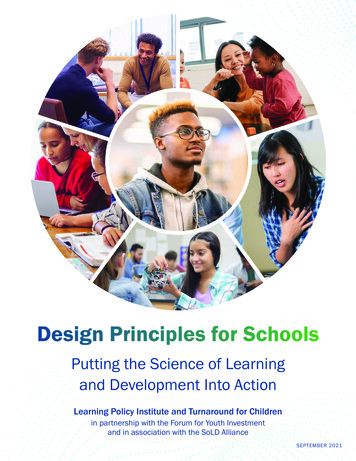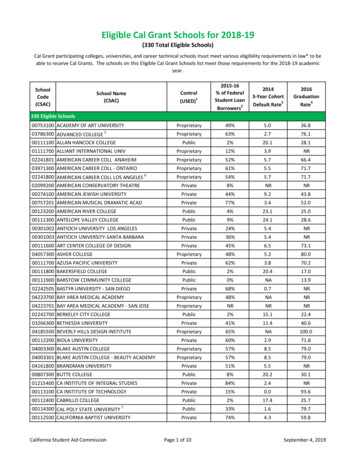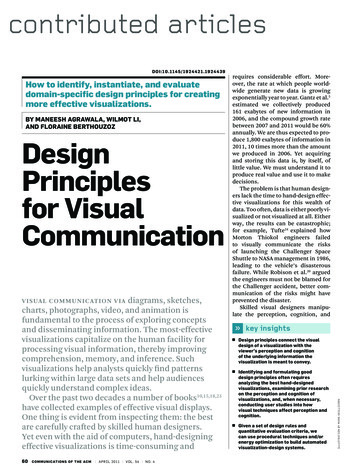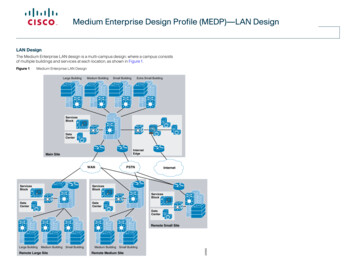
Transcription
Design Principles for SchoolsPutting the Science of Learningand Development Into ActionLearning Policy Institute and Turnaround for Childrenin partnership with the Forum for Youth Investmentand in association with the SoLD AllianceSEPTEMBER 2021
Design Principles for Schools:Putting the Science of Learningand Development Into ActionLearning Policy InstituteTurnaround for ChildrenLinda Darling-HammondPamela CantorLaura E. HernándezChristina TheokasAbby SchachnerElizabeth TijerinaSara PlasenciaIn partnership with the Forum for Youth Investmentand in association with the SoLD Alliance
This report was originally published in June 2021. It was updated in September 2021 to add andremove resources to reflect the most recent research.The appropriate citation for this report is: Learning Policy Institute & Turnaround for Children.(2021). Design principles for schools: Putting the science of learning and development into action.Design Principles for Schools: Putting the Science of Learning and Development Into Action can befound online.This work is licensed under the Creative Commons Attribution-NonCommercial 4.0 InternationalLicense. To view a copy of this license, visit ument last revised September 28, 2021
Table of ContentsAcknowledgments. iPreface: A New Purpose for Education. vExecutive Summary . viiiThe Guiding Principles for Equitable Whole Child Design.viiiConclusion.xivPositive Developmental Relationships.1Overview of Positive Developmental Relationships.2Why Positive Developmental Relationships Are Important: What the Science Says.2What Can Schools Do to Foster Positive Developmental Relationships?.4Personalizing Relationships With Students.6Supporting Relationships Among Staff. 13Building Relationships With Families. 18Summary. 23Where to Go for More Resources. 24Endnotes. 26Environments Filled With Safety and Belonging. 29Overview of Environments Filled With Safety and Belonging. 30Why Environments Filled With Safety and Belonging Are Important: What the Science Says. 30What Can Schools Do to Foster Environments Filled With Safety and Belonging?. 31Building a Safe and Caring Learning Community. 33Developing Restorative Practices That Are Trauma-Informed and Healing-Oriented. 38Fostering Inclusive, Culturally Responsive Learning Environments. 45Summary. 51Where to Go for More Resources. 52Endnotes. 55Rich Learning Experiences and Knowledge Development. 57Overview of Rich Learning Experiences. 58Why Rich Learning Experiences Are Important: What the Science Says. 59What Can Schools Do to Foster Rich Learning Experiences?. 61Supporting Diverse Learners Through Universal Design for Learning. 65Scaffolding for Success. 67Developing Effective Inquiry-Based Learning. 69Culturally Responsive Pedagogy. 74Summary. 78Where to Go for More Resources. 79Endnotes. 82
Development of Skills, Habits, and Mindsets. 84Overview of the Development of Skills, Habits, and Mindsets. 85Why Developing Skills, Habits, and Mindsets Is Important: What the Science Says. 85What Can Schools Do to Develop Skills, Habits, and Mindsets?. 87Integrating Social, Emotional, and Cognitive Development Into Learning. 92Developing Productive Habits and Mindsets. 98Summary.107Where to Go for More Resources .107Endnotes.109Integrated Support Systems.110Overview of Integrated Support Systems.111Why Integrated Support Systems Are Important: What the Science Says.112What Can Schools Do to Create Integrated Support Systems?.114Creating Comprehensive, Multi-Tiered Systems of Support .115Summary.130Where to Go for More Resources.131Endnotes.134Integrating Design Principles in Schools.137Overview.137What the Science Says About Integrated Design.137What Does an Integrated Whole Child Approach Look Like in Schools?.139Barriers and Solutions to Taking Whole Child Design to Scale.144Conclusion.150Where to Go for More Resources.150Endnotes.153Appendix A: Developing the Design Principles.154Appendix B: Goals for Youth Learning and Development.156
List of Figures and TablesFigure 1.1 Guiding Principles for Equitable Whole Child Design. ixFigure 2.1 The Dual Capacity-Building Framework for Family-School Partnerships. 21Figure 3.1 What Are Restorative Practices?. 43Figure 3.2 Affirmation Station at Bronxdale High School. 46Figure 4.1 The Universal Design for Learning Guidelines. 66Figure 4.2 Ready for Rigor: A Framework for Culturally Responsive Teaching. 75Figure 5.1 Building Blocks for Learning. 86Figure 5.2 CASEL’s SEL Framework. 88Figure 5.3 Executive Function and the Abilities It Supports. 89Figure 5.4 Ways That Social and Emotional Learning Can Be Integrated Throughoutthe School Day . 97Figure 7.1 Guiding Principles for Equitable Whole Child Design.138Table 3.1 Transforming School Environments to Be Filled With Safety and Belonging. 33Table 4.1 Transforming Schools to Advance Rich Learning Experiences. 65Table 5.1 Transforming Learning Settings for the Development of Skills, Habits,and Mindsets. 91
AcknowledgmentsMany individuals and organizations have supported the Design Principles project. Dr. LindaDarling-Hammond and Dr. Pamela Cantor were principal investigators for the project, which wasably managed by Laura E. Hernández and Abby Schachner from the Learning Policy Institute (LPI).Additional co-authors include Sara Plasencia from LPI and Christina Theokas and Elizabeth Tijerinafrom Turnaround for Children.They were advised by a deeply knowledgeable Senior Science Advisory Committee, AdvisoryCommittee, and Design Team, members of which are listed by name on the following pages. Theseindividuals provided guidance in conceptualizing the playbook and vetting the design principles.Other advisors include Jennifer DePaoli, Senior Researcher at LPI; Evo Popoff, Senior Vice Presidentat Whiteboard Advisors; and Susan Sandler, a trustee of the Sandler Foundation and the chair ofLPI’s Board of Directors, to whom we are incredibly grateful for her time and insights.The Forum for Youth Investment was also a key partner in the work. The authors thank Merita Irby,Priscilla Little, and Poonam Borah for their thought partnership in developing the design principlesfor schools and for their leadership in identifying design principles to support equitable whole childdesign in community learning settings, to be published under separate cover. The authors also thankthe SoLD Alliance for its partnership and ongoing commitment to translating the science of learningand development into practices and policies that can support equitable school transformation.In addition, we thank Erin Chase and Aaron Reeves for their editing and design contributions tothis project and the entire LPI communications team for its invaluable support in developing anddisseminating this report. Jeremy Koren from Turnaround for Children and Jackie Ross from theSoLD Alliance were also provided important design contributions and supported disseminationefforts. Without their generosity of time and spirit, this work would not have been possible.This research was supported by the S. D. Bechtel, Jr. Foundation and the Chan Zuckerberg Initiative.Core operating support for the Learning Policy Institute is also provided by the Heising-SimonsFoundation, William and Flora Hewlett Foundation, Raikes Foundation, and Sandler Foundation.We are grateful to them for their generous support. The ideas voiced here are those of the authorsand not those of our funders.External ReviewersThis report benefited from the insights and expertise of the many individuals who composed thethree intersecting committees to advise the project and review drafts of its work: The Senior Science Advisory Committee: learning scientists and human developmentexperts who were tasked with ensuring that the design principles accurately captured thescience of learning and development and supported comprehensive child development andwhole child education. The Advisory Committee: association and system leaders, policymakers, and subject matterexperts who were instrumental in advising the project on the nature and presentation ofthe design principles, how to address barriers, and how to leverage policy and practiceopportunities to amplify the work.LEARNING POLICY INSTITUTE & TURNAROUND FOR CHILDREN Design Principles for Schoolsi
The Design Team: experienced school designers, school leaders, and experts in the fieldsof learning, health, and wellness, who were instrumental in co-creating design principlesmaterials and identifying resources and illustrations of practice that captured robust,equity-oriented examples of the science of learning and development in action.We thank all of our committee members for the care and attention they gave the project and itsrelated products. The authors also offer a special thank-you to the following committee memberswho provided extensive reviews of report materials and/or lent direct written content for inclusion:Howard Adelman, Jacqueline Ancess, Ron Berger, Kimberly Cawkwell, Daren Dickson, RonniGambardella, Joan Wasser Gish, Karen Hunter Quartz, Joe Luft, Jane Quinn, Cynthia Robinson, andKelly Wilson. The authors are especially grateful to these individuals for their deep engagementwith the project team and their efforts in co-developing the playbook’s content.Senior Science Advisory Committee Marc Bornstein, Senior Investigator andHead of Child and Family Research, EuniceKennedy Shriver National Institute ofChild Health and Human Development;International Research Fellow, Institute forFiscal Studies; Senior Advisor for Research forECD Parenting Programmes, UNICEF Ron Dahl, Director, Institute of HumanDevelopment, Professor, School of PublicHealth, Adolescent Research Collaborative,University of California, Berkeley Ritchie Davidson, William James and VilasProfessor of Psychology and Psychiatry,University of Wisconsin-Madison; Founderand Director, Center for Healthy Minds Don Deshler, Williamson Family DistinguishedProfessor Emeritus of Special Education,Founder and former Director, Center forResearch on Learning, University of Kansas Carol Dweck, Lewis and Virginia EatonProfessor of Psychology, Stanford University Kris Gutiérrez, Carol Liu Professor, LearningSciences and Human Development, Universityof California, Berkeley Neal Halfon, Professor of Pediatrics, HealthPolicy and Management, and Public Policy,University of California, Los Angeles;Founding Director of the UCLA Center forHealthier Children, Families, and Communitiesii Zaretta Hammond, Education Consultant,Center for the Collaborative Classroom Mary Helen Immordino-Yang, Professor ofEducation, Psychology, and Neuroscience,Rossier School of Education, and Director ofthe USC Center for Affective Neuroscience,Development, Learning and Education(CANDLE), University of Southern California Carol Lee, Edwina S. Tarry Emeritus Professorof Education and Social Policy, Professorof Learning Sciences, Professor of AfricanAmerican Studies, Northwestern University Rich Lerner, Bergstrom Chair in AppliedDevelopmental Science and Director of theInstitute for Applied Research in YouthDevelopment, Tufts University Na’ilah Suad Nasir, President,Spencer Foundation David Osher, Vice President and InstituteFellow, American Institutes for Research Jim Pellegrino, Co-Director, LearningSciences Research Institute; Liberal Artsand Sciences Distinguished Professor andDistinguished Professor of Education,University of Illinois at Chicago Todd Rose, Co-Founder and President,Populace; Founder and Principal Investigator,Laboratory for the Science of Individuality,Harvard Graduate School of EducationLEARNING POLICY INSTITUTE & TURNAROUND FOR CHILDREN Design Principles for Schools
Claude Steele, Professor of Psychology,Stanford University Melina Uncapher, CEO and Co-Founder,Institute for Applied Neuroscience;University of California, San Francisco,Department of Neurology, Weill Institutefor Neurosciences, and Kavli Institute forFundamental Neuroscience Roger Weissberg, Chief Knowledge Officerand Board Vice Chair, Collaborative forAcademic, Social, and Emotional Learning(CASEL); Distinguished Emeritus Professor ofPsychology, University of Illinois at Chicago Philip Zelazo, Nancy M. and John E. LindahlProfessor, Institute of Child Development,University of MinnesotaAdvisory Committee Howard S. Adelman, Professor of Psychologyand Co-Director of the School Mental HealthProject and National Center for MentalHealth in Schools, University of California,Los Angeles Desmond Blackburn and Ali Picucci,New Teacher Center Sheldon Berman, Superintendent, AndoverPublic Schools Michele Cahill, Distinguished Fellow inEducation and Youth Development, NationalCenter for Civic Innovation Adam Carter, Executive Director, MarshallStreet, Summit Public Schools LaShawn Chatmon, Executive Director,National Equity Project Dan Cogan Drew, Co-Founder, Newsela Eric Cooper and Yvette Jackson, NationalUrban Alliance Deb Delisle, President, Alliance forExcellent Education Lisa Dickinson, Assistant to the President,American Federation of Teachers Jason Dougal, CEO, National Institute forSchool Leadership Nancy Duchesneau, Spencer Fellowfor Social, Emotional, and AcademicDevelopment, The Education Trust Camille Farrington, Managing Director andSenior Research Associate, University ofChicago Consortium on School Research Frances Gipson, Sanford Scholar, Harmony andInspire Programs; Director, Urban Leadership;Associate Professor, School of EducationalStudies, Claremont Graduate University Loretta Goodwin, Deputy Director,American Youth Policy Forum Nancy Guitérrez, President and CEO,The Leadership Academy Donna Harris-Aikens, Senior Director,Education Policy and Practice, NationalEducation Association (NEA) Scott Hartl and Ron Berger, EL Education Beverly Hutton, Executive Director,National Association of Secondary SchoolPrincipals (NASSP) Robert Jagers, Vice President of Research,Collaborative for Academic, Social, andEmotional Learning (CASEL) Lindsay Jones, President and CEO, NationalCenter for Learning Disabilities (NCLD) Bethany Little and Joaquin Tamayo,EducationCounsel Eva Mejia, Chief Learning and StrategyOfficer, Big Picture Learning Kathleen Minke, Executive Director, NationalAssociation of School Psychologists Karen Pittman, Co-Founder, President, andCEO, Forum for Youth Investment Shael Polakow-Suransky, President,Bank Street CollegeLEARNING POLICY INSTITUTE & TURNAROUND FOR CHILDREN Design Principles for Schoolsiii
Jane Quinn, Former Vice Presidentfor Community Schools at Children’sAid; Director, National Center forCommunity Schools Pedro Rivera, Former Secretary of Educationof Pennsylvania Lisa Roy and Amy Mart, Buffet EarlyChildhood Institute Morton Sherman, Associate ExecutiveDirector, Leadership Services, AASA Hal Smith, Senior Vice President, Education,Youth Development & Health, NationalUrban League Joseph South, Chief Learning Officer,International Society for Technology inEducation (ISTE) Georgia Thompson, National Black ChildDevelopment Institute Susan Toth, Executive Director, KIPP DC Joan Wasser Gish, Director of StrategicInitiatives at Boston College, Center forOptimized Student Support Stephanie Wood-Garnet, President,Institute for Student Achievement (ISA) Vic Vuchic, Chief Innovation Officer,Digital Promise Tony Smith, Former State Superintendent(Illinois), District Superintendent(Oakland, CA)Design Team Jacqueline Ancess, Co-Director, NationalCenter for Restructuring Education, Schools,and Teaching (NCREST) at Teachers College Merita Irby, Co-Founder and Executive VicePresident, Forum for Youth Investment Michele Cahill, Senior Advisor, XQ Institute Joe Luft, Executive Director,Internationals Network Daren Dickson, Founder,Valor Charter Academies Lydia Dobyns and Kim Cawkwell,New Tech Network Jeff Duncan-Andrade, Associate Professor,San Francisco State University; Founder,Teaching Excellence Network, CommunityResponsive Education Group, and Roses inConcrete Charter School Ronni Gambardella, School Counselor,Consultant Karen Hunter Quartz, Director, Centerfor Community Schooling, University ofCalifornia, Los Angelesiv Cynthia Leck, Partner, Transcend Education Sharon Olken, Director, Gateway High andMiddle School Carolyne Quintana, Senior Director of Social,Emotional and Academic Development,Institute for Student Achievement Cynthia Robinson-Rivers, Head of School,Van Ness Elementary Laura Sikes, Director of Content Design,Turnaround for Children Kelly Wilson, Dean, High Tech High GraduateSchool of EducationLEARNING POLICY INSTITUTE & TURNAROUND FOR CHILDREN Design Principles for Schools
Preface: A New Purpose for EducationImagine a world in which every child’s life is a succession of positive opportunities fordevelopment—opportunities through which a child can come to know who they are and discoverthe wide range of possibilities for what they can become. Imagine different types of learningsettings in which those kinds of opportunities are also intentionally built and optimized,regardless of where a child lives or attends school. Imagine, too, that educators can identify eachchild’s talents, interests, and aspirations and align them with learning opportunities designed topromote them and build on them to create new competencies.This is not the world in which we currently live, but it is one that we can now begin to create.Building on new knowledge from the science of learning and development, coupled with acommitment to advancing equity for all students, schools and community partners can bring theseopportunities to bear for every child.The need is great. Even as the United States has led the world in so many areas, it remains a countryof dramatically widening inequalities, with many children living in poverty and with significantadversities of many kinds, including food and housing insecurity, exposure to increasing gun andracial violence, and lack of access to health and mental health services. During the pandemic, thedramatic inequalities in the conditions of living in America have been exposed, along with thedramatic inequalities in the conditions of learning in America.For the past century, the U.S. education system has primarily focused on the delivery of subjectmatter content—especially in mathematics and English language arts—using approaches thatpresume a bell curve of student ability, with instruction targeted to a mythical “average student.” Itis a system that was not designed to unlock the potential in each and every child or to develop thewhole child across the multiple domains of development. The resulting structures and practices inmany schools are not adaptable to the variation in how different students learn. They do not usedifferentiated and personalized approaches, and they are not attuned to the development of deeperlearning skills or to the habits and mindsets that support the creativity and resilience demanded inthe 21st century.In addition, the U.S. education system was not designed for equity; it was designed forinequitable access to rich learning opportunities, which has disadvantaged marginalized groupsbased on race, income, gender, language, and culture. Indeed, it was designed to select andsort, rather than to develop potential, and—through segregation, unequal school funding, andtracking systems—institutionalized racism and classism are baked into the design of the systemitself. This system reinforces beliefs about who has potential and who is worthy of opportunitythat we now know are false, harmful, and discriminatory on both scientific and moral grounds.Such beliefs risk squandering the potential of millions of students each year, and growinginequality in our society.The COVID-19 pandemic, the related economic recession, and ongoing racialized violence havelaid bare the inequities of experience and opportunity for many young people in our country. Theinequities shaping and challenging our children’s futures before the coronavirus, heightened byanti-Black and other forms of racial violence, have been dramatically amplified by these concurrentLEARNING POLICY INSTITUTE & TURNAROUND FOR CHILDREN Design Principles for Schoolsv
and devastating events. These forces cry out for a redesign of all the systems that support ourchildren and families and educate and prepare our youth. The situation facing our country demandsthat we use this disruption as an empowering stimulus for transformational societal, educational,and economic change, defined by the goals of social justice, multidimensional equity, and theopportunity for each and every young person to thrive.It may be hard to find silver linings through so much suffering, but as recovery and reopening takeshape, there will be a chance to design something very different and better for children and youth.This is the design challenge we are solving for in the Design Principles project.The Opportunity We FaceHere is the opportunity we have today: Developmental and learning science tell an optimistic storyabout what all young people are capable of. There is burgeoning scientific knowledge about thebiological systems that govern human life, including the systems of the human brain. Researcherswho are studying the brain’s structure, wiring, and metabolism are documenting the deep extentto which brain growth and life experiences are interdependent and malleable. (See “FoundationalScience of Learning and Development Research” for the key articles and reports that form the basisof this work.) Because researchers know so much more about the brain and development than theydid when the 20th-century U.S. education system was designed, we can now use this knowledge todesign a system in which all individuals are able to take advantage of high-quality opportunities fortransformative learning and development.Foundational Science of Learning and Development ResearchThree papers synthesizing this knowledge base form the basis of the design principles for schoolspresented here. For those seeking access to the research underlying this work, these papers arepublicly available: Cantor, P., Osher, D., Berg, J., Steyer, L., & Rose, T. (2018). Malleability, plasticity, andindividuality: How children learn and develop in context. Applied Developmental Science,23(4), 307–337. https://doi.org/10.1080/10888691.2017.1398649. Darling-Hammond, L., Flook, L., Cook-Harvey, C., Barron, B. J., & Osher, D. (2019). Implicationsfor educational practice of the science of learning and development. Applied DevelopmentalScience, 24(2), 97–140. https://doi.org/10.1080/10888691.2018.1537791. Osher, D., Cantor, P., Berg, J., Steyer, L., & Rose, T. (2018). Drivers of human development:How relationships and context shape learning and development. Applied DevelopmentalScience, 24(1), 6–36. ARNING POLICY INSTITUTE & TURNAROUND FOR CHILDREN Design Principles for Schools
This playbook suggests a set of engineering principles that were developed by a group ofeducators, practitioners, scientists, and parents, building on the knowledge we have today andthe contributions of many in the field to nurture innovations, new models, and new enablingpolicies. (See Appendix A for a full description of how the design principles were co-created.)At their foundation, the design principles are intended to advance the following goals for youthlearning and development (see Appendix B for a more in-depth treatment of the goals and theirembedded components): Learners can think critically and creatively to solve complex problems. Learners deeply understand content and can apply their knowledge beyond the classroom. Learners are self-aware and engage meaningfully with others. Learners hold a positive sense of identity, self-potential, purpose, and direction. Learners make healthy life choices. Learners are empa
The Design Team: experienced school designers, school leaders, and experts in the fields of learning, health, and wellness, who were instrumental in co-creating design principles materials and identifying reso










